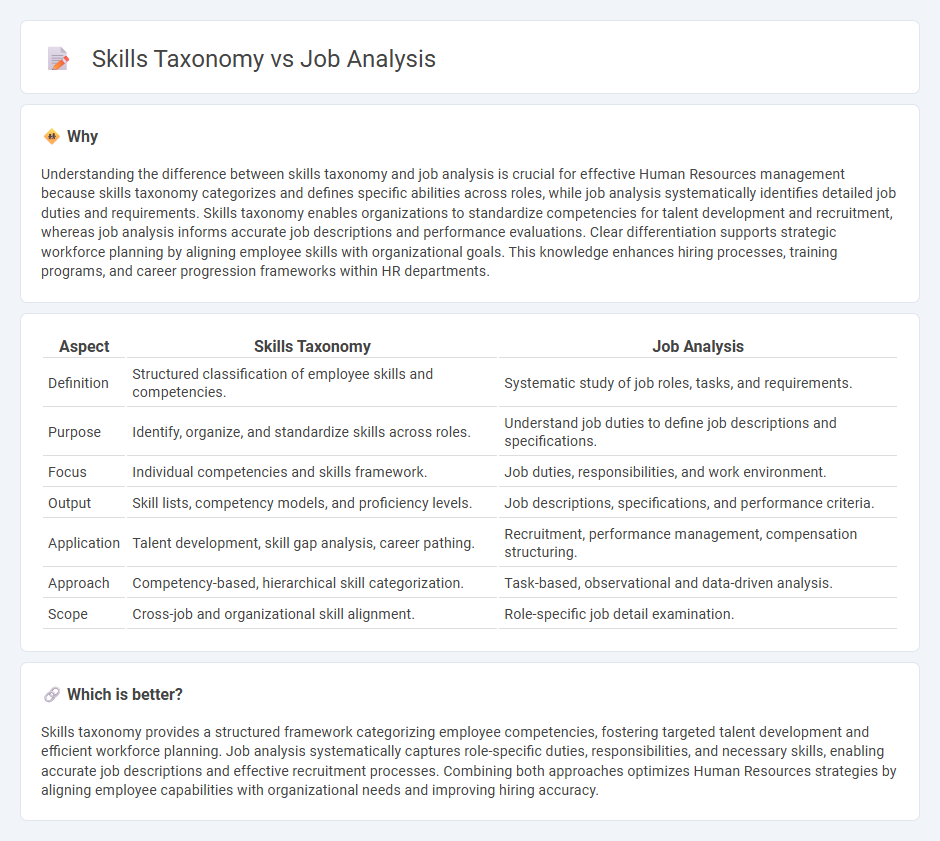
Skills taxonomy organizes employee competencies into structured categories, enhancing talent management and aligning workforce capabilities with organizational goals. Job analysis systematically examines job roles to identify essential tasks, responsibilities, and required skills, serving as a foundation for effective recruitment and performance evaluation. Discover how integrating skills taxonomy and job analysis can optimize human resource strategies and workforce development.
Why it is important
Understanding the difference between skills taxonomy and job analysis is crucial for effective Human Resources management because skills taxonomy categorizes and defines specific abilities across roles, while job analysis systematically identifies detailed job duties and requirements. Skills taxonomy enables organizations to standardize competencies for talent development and recruitment, whereas job analysis informs accurate job descriptions and performance evaluations. Clear differentiation supports strategic workforce planning by aligning employee skills with organizational goals. This knowledge enhances hiring processes, training programs, and career progression frameworks within HR departments.
Comparison Table
| Aspect | Skills Taxonomy | Job Analysis |
|---|---|---|
| Definition | Structured classification of employee skills and competencies. | Systematic study of job roles, tasks, and requirements. |
| Purpose | Identify, organize, and standardize skills across roles. | Understand job duties to define job descriptions and specifications. |
| Focus | Individual competencies and skills framework. | Job duties, responsibilities, and work environment. |
| Output | Skill lists, competency models, and proficiency levels. | Job descriptions, specifications, and performance criteria. |
| Application | Talent development, skill gap analysis, career pathing. | Recruitment, performance management, compensation structuring. |
| Approach | Competency-based, hierarchical skill categorization. | Task-based, observational and data-driven analysis. |
| Scope | Cross-job and organizational skill alignment. | Role-specific job detail examination. |
Which is better?
Skills taxonomy provides a structured framework categorizing employee competencies, fostering targeted talent development and efficient workforce planning. Job analysis systematically captures role-specific duties, responsibilities, and necessary skills, enabling accurate job descriptions and effective recruitment processes. Combining both approaches optimizes Human Resources strategies by aligning employee capabilities with organizational needs and improving hiring accuracy.
Connection
Skills taxonomy organizes and categorizes employee competencies, forming the foundation for precise job analysis by identifying the specific skills required for each role. Job analysis collects detailed information about job duties and responsibilities, which is then mapped to the skills taxonomy to ensure alignment between job requirements and workforce capabilities. This connection enhances talent management, recruitment, and training strategies by providing a clear framework for matching individual skills to organizational needs.
Key Terms
**Job Analysis:**
Job analysis systematically identifies and documents the specific tasks, responsibilities, and requirements of a job role, providing a foundation for effective recruitment, training, and performance evaluation. It captures critical job elements such as duties, necessary skills, work environment, and outcome expectations to ensure alignment with organizational goals. Explore in-depth insights on how job analysis enhances workforce planning and talent management.
Task Identification
Job analysis centers on systematically identifying and detailing specific tasks, duties, and responsibilities associated with a job role to understand its requirements and performance standards. Skills taxonomy organizes and categorizes these tasks into distinct skill sets and competencies, facilitating easier skill matching and workforce development. Explore more to understand how aligning task identification enhances talent management and operational efficiency.
Job Description
Job analysis provides a systematic process to identify the duties, responsibilities, and qualifications required for a specific job, forming the foundation for detailed job descriptions. Skills taxonomy organizes and categorizes skills across various roles, enabling clearer identification of essential competencies within job descriptions. Explore how integrating job analysis with skills taxonomy enhances the accuracy and relevance of job descriptions.
Source and External Links
Job Analysis: Importance, Methods, and Implementation - Indeed - Job analysis involves gathering and analyzing details about a job's responsibilities, duties, and requirements to inform hiring decisions and personnel management.
Job Analysis: A Practical Guide [FREE Templates] - AIHR - This guide offers a systematic approach to job analysis, focusing on identifying job responsibilities and requirements to enhance recruitment and organizational structure.
Job Analysis - Provides a detailed description of a job by systematically identifying tasks and competencies required for successful job performance.
 dowidth.com
dowidth.com